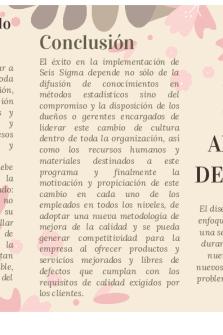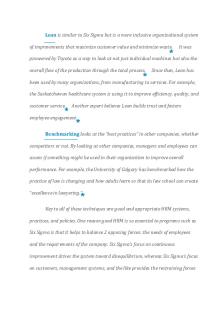LEAN SIX SIGMA BLACK BELT HANDBOOK Tools and Methods for Process Acceleration PDF

| Title | LEAN SIX SIGMA BLACK BELT HANDBOOK Tools and Methods for Process Acceleration |
|---|---|
| Author | Mario Patterson |
| Pages | 596 |
| File Size | 6.7 MB |
| File Type | |
| Total Downloads | 26 |
| Total Views | 836 |
Summary
THE LEAN SIX SIGMA BLACK BELT HANDBOOK Tools and Methods for Process Acceleration Fra n k Voehl • H . Jame s Ha r ri n g t o n C h u ck M i gnosa • R i ch Ch a r ro n THE LEAN SIX SIGMA BLACK BELT HANDBOOK Tools and Methods for Process Acceleration THE LEAN SIX SIGMA BLACK BELT HANDBOOK Tools and Me...
Description
THE
LEAN SIX SIGMA BLACK BELT HANDBOOK
Tools and Methods for Process Acceleration
Fra n k Voehl • H . Jame s Ha r ri n g t o n C h u ck M i gnosa • R i ch Ch a r ro n
THE
LEAN SIX SIGMA BLACK BELT HANDBOOK
Tools and Methods for Process Acceleration
THE
LEAN SIX SIGMA BLACK BELT HANDBOOK
Tools and Methods for Process Acceleration Fra nk Voeh l • H . Jam es H arrin g t on Chuck Mig n osa • R i ch Ch arron
Boca Raton London New York
CRC Press is an imprint of the Taylor & Francis Group, an informa business
A PRODUCTIVITY PRESS BOOK
CRC Press Taylor & Francis Group 6000 Broken Sound Parkway NW, Suite 300 Boca Raton, FL 33487-2742 © 2014 by Taylor & Francis Group, LLC CRC Press is an imprint of Taylor & Francis Group, an Informa business No claim to original U.S. Government works Version Date: 20130426 International Standard Book Number-13: 978-1-4665-5469-6 (eBook - PDF) This book contains information obtained from authentic and highly regarded sources. Reasonable efforts have been made to publish reliable data and information, but the author and publisher cannot assume responsibility for the validity of all materials or the consequences of their use. The authors and publishers have attempted to trace the copyright holders of all material reproduced in this publication and apologize to copyright holders if permission to publish in this form has not been obtained. If any copyright material has not been acknowledged please write and let us know so we may rectify in any future reprint. Except as permitted under U.S. Copyright Law, no part of this book may be reprinted, reproduced, transmitted, or utilized in any form by any electronic, mechanical, or other means, now known or hereafter invented, including photocopying, microfilming, and recording, or in any information storage or retrieval system, without written permission from the publishers. For permission to photocopy or use material electronically from this work, please access www.copyright. com (http://www.copyright.com/) or contact the Copyright Clearance Center, Inc. (CCC), 222 Rosewood Drive, Danvers, MA 01923, 978-750-8400. CCC is a not-for-profit organization that provides licenses and registration for a variety of users. For organizations that have been granted a photocopy license by the CCC, a separate system of payment has been arranged. Trademark Notice: Product or corporate names may be trademarks or registered trademarks, and are used only for identification and explanation without intent to infringe. Visit the Taylor & Francis Web site at http://www.taylorandfrancis.com and the CRC Press Web site at http://www.crcpress.com
This book is dedicated to the thousands of Lean Six Sigma Belts that Jim Harrington and I have had the privilege of mentoring and certifying over the past 10 years. And to the Four Horsemen of the Quality Movement—Deming, Juran, Crosby, and Feigenbaum. Thank you for teaching us how to teach, and for encouraging us to find a better way. Frank Voehl I dedicate this book to the person who created me and gave me her love—my mother, Carrie, and to the person who helped mold my life and made me what I am—my wife, Marguerite. H. James Harrington This book is dedicated to two people who have had the most profound impacts on my life— my dad and my daughter. To my late dad, Edmund J. Charron, who in my formative years provided a steady stream of learning exercises through quotations, principles, and actions. Unbeknownst to me at the time, these gems of his essence would intermittently emerge throughout my life and guide me just when I needed them the most. To my precious daughter Hali, who as a child taught me that love is the most powerful force in the universe. Like my father before me, may I provide to you through word and deed values to live by. Richard Charron
Contents Acknowledgments............................................................................. xxiii About the Authors............................................................................... xxv
Section 1 Overview of Lean Six Sigma Chapter 1 Introduction to Lean Six Sigma Methodology.................. 7 In a Nutshell..................................................................................8 Introduction..................................................................................9 The Notion of Standing upon the Shoulders of Giants....11 LSS Cultural Building Blocks..............................................11 Connecting the Tools with Engineering Goals.................12 What Came First—Six Sigma or Lean?...................................12 Technical Competency Levels..................................................16 LSS Belt Levels............................................................................18 Lean Six Sigma Master Black Belt (LSSMBB)....................18 Lean Six Sigma Black Belt (LSSBB).....................................19 Lean Six Sigma Green Belt (LSSGB)...................................22 Lean Six Sigma Yellow Belt (LSSYB)...................................24 Lean Six Sigma Blue Belt......................................................24 Five Phases of an LSS Improvement Project...........................25 Summary.....................................................................................26 Chapter 2 Process Improvement and Lean Six Sigma...................... 27 In a Nutshell................................................................................27 Introduction................................................................................27 An LSS Quality Focus on the Business Process.................... 28 Some Basic Definitions..............................................................29 Objectives of Process Improvement........................................ 30 Cross-Functional Focus.............................................................32 Critical Success Factors.............................................................32
vii
viii • Contents Nature of LSS Process Improvement.......................................32 Advantages of LSS Process Improvement..........................33 Determining Process Ownership............................................ 34 The Nature of Business Processes....................................... 34 Management’s Traditional Focus....................................... 34 Cross-Functional Focus........................................................35 Process Ownership.....................................................................36 The Process Owner................................................................37 The Process Management Committee................................37 The Process Quality Team....................................................38 Selection, Responsibilities, and Authority of the Process Owner............................................................................38 Selection of the Process Owner...........................................39 Responsibilities of the Process Owner................................39 Authority of the Process Owner......................................... 40 Process Definition and the Process Model.............................41 Definition of Process Mission and Scope.......................... 42 Summary.................................................................................... 44 Exercise........................................................................................45
Section 2 The Lean Journey into Process Improvement Chapter 3 Waste Identification.......................................................... 59 In a Nutshell................................................................................59 Overview..................................................................................... 60 What Is Variation?..................................................................... 60 How Do We Chart Variation?..............................................61 Why Is Understanding and Controlling Variation So Important?.........................................................................62 What Is Waste?...........................................................................63 Defining the Value-Added Work Components.................63 How Does Waste Creep into a Process?..................................65 The Power of Observation.........................................................65 Seeing with New Eyes................................................................67 Waste 1: Overproduction......................................................67 What Causes Overproduction?...................................... 68 How to Identify Overproduction....................................70
Contents • ix Waste 2: Excess Inventories..................................................72 What Causes Excess Inventory?.....................................72 How to Identify Excess Inventory..................................75 Waste 3: Defects.....................................................................76 What Causes Defects?......................................................76 How to Identify Defects...................................................78 Waste 4: Extra Processing................................................... 80 What Causes Processing Waste?.................................... 80 How to Identify Processing Waste.................................82 Waste 5: Waiting....................................................................83 What Causes Waiting Waste?.........................................83 How to Identify Waiting Waste..................................... 86 Waste 6: Motion.....................................................................87 What Causes Motion Waste?..........................................87 How to Identify Motion Waste.......................................89 Waste 7: Transportation.......................................................89 What Causes Transportation Waste?.............................89 How to Identify Transportation Waste..........................92 Waste 8: Underutilized Employees.....................................92 What Causes Underutilized Employees Waste?...........93 How to Identify Underutilized Employees Waste........95 Waste 9: Behavior..................................................................95 How to Identify Behavior Waste.................................... 96 Summary.....................................................................................97 Chapter 4 Lean Concepts, Tools, and Methods................................ 99 Overview..................................................................................... 99 Traditional Organization Operational Philosophy.............105 Lean Operational Philosophy.................................................107 Lean Management Concepts..................................................107 Waste.....................................................................................108 Value-Added Activities.......................................................108 No-Value-Added Activities................................................108 Business-Value-Added Activities......................................109 Waste Identification............................................................110 Waste Elimination...............................................................110 Value Stream........................................................................111 Value Stream Management................................................112
x • Contents Continuous Flow.................................................................113 Pull Systems..........................................................................113 Point of Use Storage............................................................114 Quality at the Source...........................................................114 Just-in-Time..........................................................................115 Kaizen....................................................................................116 5M’s—Materials, Machines, Manpower, Methods, and Measurements..............................................................116 Key Process Input Variables (KPIVs)................................117 Key Process Output Variables (KPOVs)...........................117 Lean Tools..................................................................................118 5S Workplace Organization and Standardization..........118 Just the Facts....................................................................119 5S Means Action.............................................................119 Common Omissions When Implementing 5S.......... 123 Overall Equipment Effectiveness...................................... 124 Just the Facts................................................................... 124 How to Use OEE.............................................................125 Applying OEE in Nonmanufacturing Environments................................................................. 126 Mistake Proofing.................................................................127 Just the Facts....................................................................127 How to Use Mistake Proofing...................................... 128 Cellular Manufacturing......................................................129 Just the Facts....................................................................129 How to Create Manufacturing Cells............................130 Kanban..................................................................................131 Just the Facts....................................................................132 How to Use Kanban........................................................132 Value Stream Mapping.......................................................133 Just the Facts....................................................................133 Managing with Maps.................................................... 134 Visual Controls....................................................................135 Just the Facts....................................................................136 How to Use Visual Controls..........................................136 The Power of Lean Concepts and Lean Tools.......................136 Composite U-Cell Case Study...........................................138 Lean Six Sigma Concepts and Tools Used...................139 Summary...................................................................................140
Contents • xi Chapter 5 Three Faces of Change—Kaizen, Kaikaku, and Kakushin.......................................................................... 143 In a Nutshell..............................................................................143 Introduction..............................................................................145 Resistance to Change..........................................................146 Fear of the Unknown..........................................................146 Measurement Systems.........................................................146 Beliefs....................................................................................147 Overcoming Resistance to Change........................................147 Leaving Old Beliefs Behind................................................148 Considering New Possibilities...........................................149 Emergence of LSS................................................................149 Three Faces of Change.............................................................149 Kaizen—Continuous Improvement..................................150 Kaizen and You Method.....................................................152 Kaizen for Process Troubleshooting.................................152 Step 1: Go to Gemba.......................................................153 Step 2: Conduct Gembutsu............................................153 Step 3: Take Temporary Countermeasures “on the Spot”...........................................................................153 Step 4: Find Root Causes................................................153 Step 5: Standardize to Prevent Recurrence................ 154 Kaizen Teams...................................................................... 154 Possible Target Areas for Kaizen Teams...........................155 Preparing for Kaizen...........................................................155 Team Member Roles in Kaizen..........................................156 Overcoming Obstacles during Kaizen..............................156 Kaikaku—Transformation of Mind.......................................158 How Do We Recognize Kaikaku (Transformation of Mind)?...................................................................................158 Kaikaku in Cell Design.......................................................159 Kaikaku in Facility Layouts...............................................160 Kakushin (Innovation)............................................................163 The 20-20 Innovation Process............................................163 Summary...................................................................................170
xii • Contents
Section 3 SSBB Overview Chapter 6 On Integrating LSS and DMAIC with DMADV........... 179 In a Nutshell..............................................................................179 Overview....................................................................................180 Goals of Lean DMADV...........................................................182 Lean Design..........................................................................182 Goals of DMAIC/DMADV.....................................................185 Overview of How DMAIC Works.....................................185 Overview of How DMADV Works...................................186 Comparing DMAIC and DMADV........................................187 Integrating Lean with DMAIC/DMADV.............................188 Root Cause Analysis and Lean......................................189 Groups of Root Cause Analysis Tools..........................191 Summary...................................................................................194
Section 4 LSSBB Advanced Nonstatistical Tools Chapter 7 Black Belt Nonstatistical Tools (A through M)............. 213 Introduction..............................................................................213 5S.................................................................................................214 Just the Facts.........................................................................215 Example.................................................................................215 Additional Reading.............................................................216 Benchmarking of Processes....................................................216 Just the Facts.........................................................................216 What Will Benchmarking Do for You?............................218 History of Benchmarking...................................................219 Types of Benchmarking..................................................... 220 Internal Benchmarking................................................. 220 External Benchmarking................................................ 222 Guidelines and Tips............................................................ 225 What Are the Primary Reasons for Using Process Benchmarking?................................................................... 226
Contents • xiii The What......................................................................... 227 The How.......................................................................... 227 The Five Phases of Internal and External Combined Benchmarking Process...................................................... 228 Examples.............................................................................. 229 Additional Reading....
Similar Free PDFs

SIX Sigma
- 4 Pages

Aplicacion SIX Sigma triptico
- 2 Pages

Calidad total six Sigma
- 19 Pages

Green belt in lean examenvragen
- 168 Pages

Six sigma HR
- 2 Pages

Metode Penelitian Six Sigma
- 1 Pages

SIx sigma el TPS
- 15 Pages

Makalah Six Sigma
- 20 Pages

Metodología SIX Sigma Y DPMO
- 14 Pages
Popular Institutions
- Tinajero National High School - Annex
- Politeknik Caltex Riau
- Yokohama City University
- SGT University
- University of Al-Qadisiyah
- Divine Word College of Vigan
- Techniek College Rotterdam
- Universidade de Santiago
- Universiti Teknologi MARA Cawangan Johor Kampus Pasir Gudang
- Poltekkes Kemenkes Yogyakarta
- Baguio City National High School
- Colegio san marcos
- preparatoria uno
- Centro de Bachillerato Tecnológico Industrial y de Servicios No. 107
- Dalian Maritime University
- Quang Trung Secondary School
- Colegio Tecnológico en Informática
- Corporación Regional de Educación Superior
- Grupo CEDVA
- Dar Al Uloom University
- Centro de Estudios Preuniversitarios de la Universidad Nacional de Ingeniería
- 上智大学
- Aakash International School, Nuna Majara
- San Felipe Neri Catholic School
- Kang Chiao International School - New Taipei City
- Misamis Occidental National High School
- Institución Educativa Escuela Normal Juan Ladrilleros
- Kolehiyo ng Pantukan
- Batanes State College
- Instituto Continental
- Sekolah Menengah Kejuruan Kesehatan Kaltara (Tarakan)
- Colegio de La Inmaculada Concepcion - Cebu






